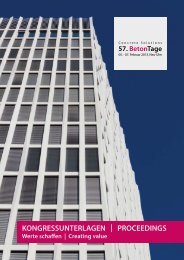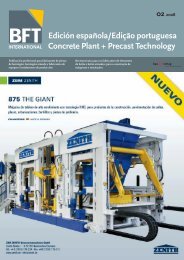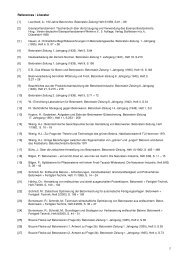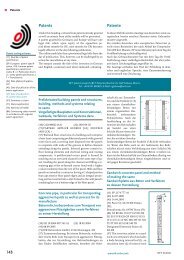Concrete Plant + Precast Technology Betonwerk ... - BFT International
Concrete Plant + Precast Technology Betonwerk ... - BFT International
Concrete Plant + Precast Technology Betonwerk ... - BFT International
Sie wollen auch ein ePaper? Erhöhen Sie die Reichweite Ihrer Titel.
YUMPU macht aus Druck-PDFs automatisch weboptimierte ePaper, die Google liebt.
crete sand could be used as a secondary raw material in<br />
cement clinker production in order to achieve the complete<br />
recycling of used concrete in concrete construction.<br />
This new potential use of secondary materials was investigated<br />
on the basis of the specifi c situation at three cement<br />
plants and the types of crushed concrete sand available<br />
there. Their use proved to be technically possible in principle<br />
due to the favorable composition of the crushed sand<br />
but requires, among other factors, a suffi ciently homogeneous<br />
material. Because of its composition (Fig. 1),<br />
crushed concrete sand mainly substitutes silicon carriers<br />
in the raw material mix, which is why the silicon content<br />
is usually the variable that limits utilization. In specifi c<br />
cases, up to 8% of crushed concrete sand may be used in<br />
the raw material mix. The use of primary raw materials<br />
may be minimized, and the amount of thermal energy<br />
and CO 2 emissions may be reduced in the clinker burning<br />
process because of the presence of yet uncarbonated cement<br />
paste in the crushed concrete sand. The reduction<br />
achievable for the same clinker quality depends on the<br />
amount of input materials and on the total amount of CO 2<br />
captured in the crushed concrete sand and in the substituted<br />
raw materials. These benefi ts also become apparent<br />
in the life cycle assessment where upstream processes<br />
such as transport are included as well.<br />
As a new type of material re-use in concrete production,<br />
the use of bottom ashes from municipal solid waste<br />
incinerators (MSWI) as secondary aggregates was investigated.<br />
Due to their chemical-mineralogical composition,<br />
these ashes can generally be used as concrete aggregates.<br />
However, constituents with a deleterious eff ect on the<br />
concrete cause diffi culties in this recycling process. A sustainability<br />
assessment resulted in the conclusion that well<br />
workable C 20/25 concretes can generally be produced<br />
with MSWI bottom ashes as aggregates. However, damage<br />
to the concrete can be avoided only if the bottom ashes are<br />
treated very thoroughly in order to further reduce their<br />
harmful constituents. If other ash processing products are<br />
not taken into account, the provision of MSWI bottom ashes<br />
as a concrete aggregate will be more costly in environmental<br />
terms than the provision of natural aggregates.<br />
auch in der ökobilanziellen Betrachtung nieder, in der ergänzend<br />
Vorkettenprozesse wie z. B. Transporte berücksichtigt<br />
werden.<br />
Als neuer Verwertungsweg in der Herstellung von Beton<br />
wurde die Verwendung von Hausmüllverbrennungsaschen<br />
(MV-Aschen) als sekundäre Gesteinskörnung betrachtet.<br />
Dieser Verwertungsweg erscheint auf Grund der<br />
chemisch-mineralogischen Zusammensetzung der Müllverbrennungsaschen<br />
grundsätzlich möglich, wird jedoch<br />
durch betonschädigende Inhaltsstoff e erschwert. Eine<br />
Nachhaltigkeitsbewertung ergibt, dass mit MV-Aschen<br />
als Gesteinskörnung prinzipiell gut verarbeitbare Betone<br />
der Festigkeitsklasse C 20/25 hergestellt werden können.<br />
Betonschäden sind allerdings nur durch eine sehr intensive<br />
Ascheaufbereitung zur weiteren Reduzierung betonschädigender<br />
Inhaltsstoff e zu vermeiden. Wenn andere<br />
Produkte der Aufbereitung nicht in Rechnung gestellt<br />
werden, ist die Bereitstellung der MV-Aschen als Gesteinskörnungen<br />
für Beton im Vergleich zur Bereitstellung<br />
von natürlichen Gesteinskörnungen insgesamt aufwändiger.<br />
<strong>BFT</strong> 02/2010<br />
Podium 1<br />
Dipl.-Ing. Tristan Herbst,<br />
BAM Bundesanstalt für<br />
Materialforschung und<br />
-prüfung, Berlin<br />
tristan.herbst@bam.de<br />
Geb. 1977; Studium des Bauingenieurwesens<br />
an der TU<br />
Braunschweig; 2005–2008<br />
Bauingenieur im Bereich<br />
Geotechnik im Sachverständigenbüro<br />
Dr.-Ing. Gödecke,<br />
Augsburg; seit 2008 wiss. Mitarbeiter<br />
an der BAM Bundesanstalt<br />
für Materialforschung<br />
und -prüfung in der Abteilung<br />
Bauwerkssicherheit.<br />
Dr. rer nat. Stefan Schäfer,<br />
Forschungsinstitut der Zementindustrie,<br />
Düsseldorf<br />
scs@vdz-online.de<br />
Geb. 1968; Studium der Chemie<br />
an der Ruhr-Universität<br />
Bochum; 1995–1999 wiss.<br />
Mitarbeiter Deutsche Montan<br />
Technologie; 1999 Promotion<br />
an der Universität Essen; seit<br />
1999 wiss. Mitarbeiter am<br />
Forschungsinst. der Zementindustrie<br />
in der Abteilung<br />
Umwelt und Betriebstechnik,<br />
dort stellvertretender Leiter,<br />
Düsseldorf.<br />
Dipl.-Ing. Maik Seidel,<br />
Forschungsinstitut der Zementindustrie,<br />
Düsseldorf<br />
sei@vdz-online.de<br />
Geb. 1973; Studium des<br />
Bauingenieurwesens an der<br />
Bauhaus-Universität Weimar;<br />
2000–2007 technischer<br />
Angestellter bei der Max<br />
Bögl Bauunternehmung,<br />
Neumarkt; seit 2007 wiss.<br />
Mitarbeiter am Forschungsinstitut<br />
der Zementindustrie in<br />
der Abteilung Betontechnik,<br />
Düsseldorf.












